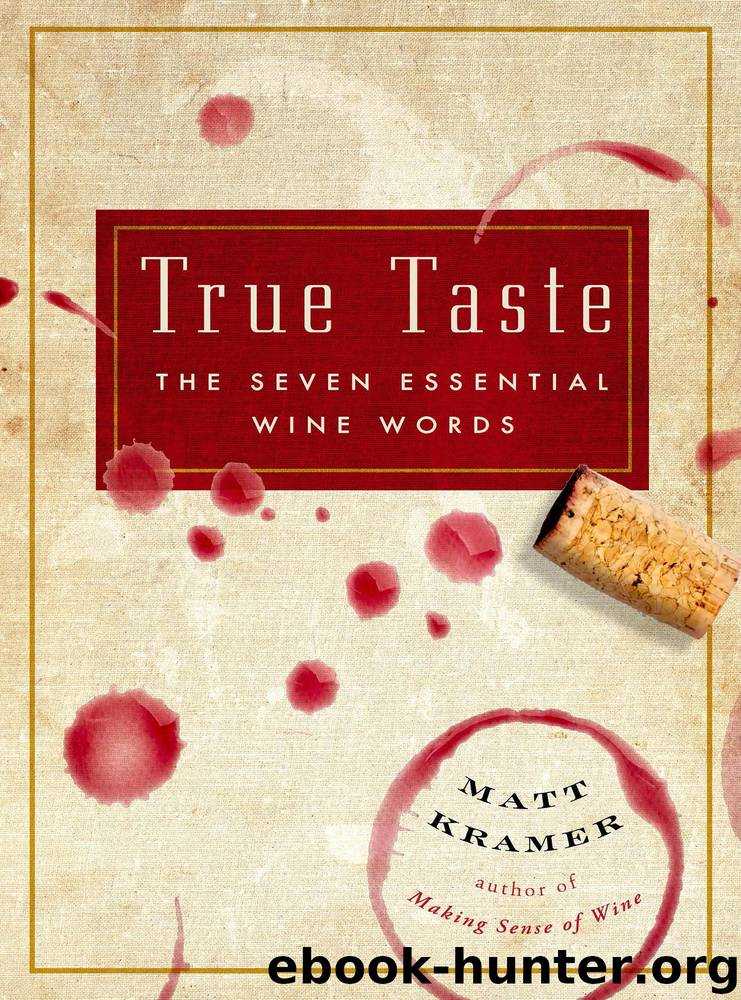True Taste by Matt Kramer

Author:Matt Kramer
Language: eng
Format: mobi, epub
Publisher: Cider Mill Press
Published: 2015-12-06T00:14:38.552000+00:00
CHAPTER 6
FINESSE
It’s more of a finesse game, it’s more small ball, which personally I don’t really care much for. I like kind of smash-mouth, old-school basketball.
—Kobe Bryant
Los Angeles Times
It’s not a coincidence that, with the possible exception of tennis, no sport sees the word “finesse” invoked more often than basketball. And even though I’m no sports fan myself, I have found basketball imagery one of the most effective in conveying at least a visual notion of finesse.
What is finesse in wine? It’s one of those “you know it when you see it” things—or in this case, taste it. Finesse is about delivery, how a wine’s flavors and texture are handed to you. Think of a basketball player going for a layup. Finesse is when the player is driving toward the basket, gracefully leaping up with the ball rolling off his fingertips and disappearing friction-free into the basket. The same play can, of course, be done brutally: the slam dunk. No one has ever suggested that as having finesse.
Fine wine isn’t, however, a matter of getting a ball through a hoop, of winning or losing, never mind how. That’s why finesse matters so much in wine and so little in sports. Wine is an end in itself; there is no finish line to cross. In sports, finesse is an added bonus, a fillip of graceful beauty in movement and skill. With wine, finesse is intrinsic to full accomplishment.
Clearly, the word finesse is a Frenchified version of fine-ness. This alone tells you how structurally important finesse is in establishing the refinement of a wine. No one has ever praised a wine for being coarse. Granted, establishing finesse is a matter of judgment and far from an exact science. Indeed, it can’t be measured, which is why wine scientists scorn the very idea of finesse.
Finesse is like the Shaolin priest in Kung Fu who, “looked for, he cannot be seen. Felt, he cannot be touched.” In other words, finesse cannot be rationally proved as real. No winemaking technique insures finesse. This drives the “causality crowd” crazy. Consequently, wine scientists have banned both the concept and the term itself. “This word [finesse] needs a rest, along with ‘delicate’ and ‘elegant,’ ” wrote professors Maynard Amerine and Edward B. Roessler in Wines: Their Sensory Evaluation.6 This is a willfully blindered view of quality in wine, a form of narrow-mindedness justified by an abiding belief in scientism.
Well, they work their side of the street and wine lovers—connoisseurs, really—work theirs. Finesse exists. It’s real. And not only does it exist, but what’s more, finesse is an foundational element of all truly great wines anywhere in the world regardless of grape variety or style.
If we proscribe the word finesse as part of our wine vocabulary we do so at genuine risk. “To name a thing is to make it real,” said Albert Camus (it’s attributed to him, anyway). Wine values, like any others, lose their life essence if not invoked. Finesse will become less important if it’s never mentioned.
Download
This site does not store any files on its server. We only index and link to content provided by other sites. Please contact the content providers to delete copyright contents if any and email us, we'll remove relevant links or contents immediately.
| Buying Guides | Cellars |
| Champagne | Collecting |
| Spirits | Whiskey |
| Wine | Wine Pairing |
| Wine Tasting |
Whiskies (Collins Gem) by dominic roskrow(42191)
101 Whiskies to Try Before You Die by Ian Buxton(42158)
Whiskies Galore by Ian Buxton(40305)
Craft Beer for the Homebrewer by Michael Agnew(17440)
Right Here, Right Now by Georgia Beers(3494)
Not a Diet Book by James Smith(2715)
Water by Ian Miller(2579)
The Coffee Dictionary by Maxwell Colonna-Dashwood(2527)
Kitchen confidential by Anthony Bourdain(2299)
Coffee for One by KJ Fallon(2005)
Smuggler's Cove: Exotic Cocktails, Rum, and the Cult of Tiki by Martin Cate & Rebecca Cate(1978)
Beer is proof God loves us by Charles W. Bamforth(1915)
Superfood Smoothie Bowls: Delicious, Satisfying, Protein-Packed Blends that Boost Energy and Burn Fat by Chace Daniella(1899)
Talking as Fast as I Can by Lauren Graham(1827)
Bourbon: A Savor the South Cookbook by Kathleen Purvis(1787)
A Short History of Drunkenness by Forsyth Mark(1715)
Eat With Intention by Cassandra Bodzak(1684)
Cocktails for the Holidays by Editors of Imbibe magazine(1623)
Colombia Travel Guide by Lonely Planet(1606)
